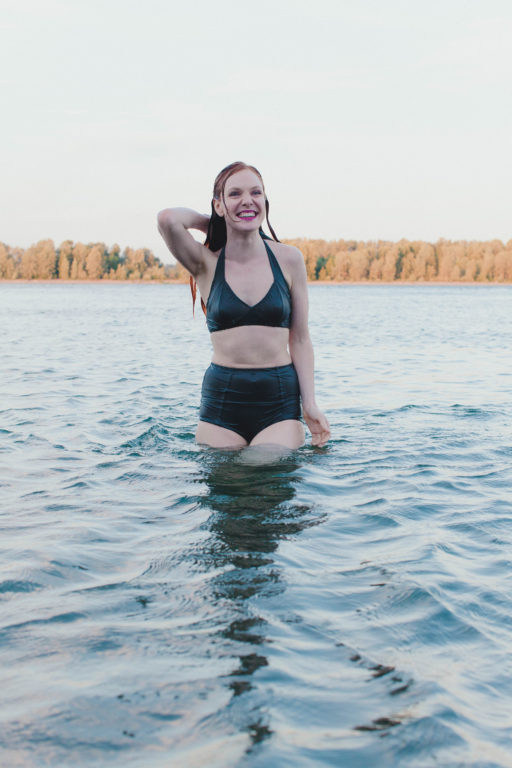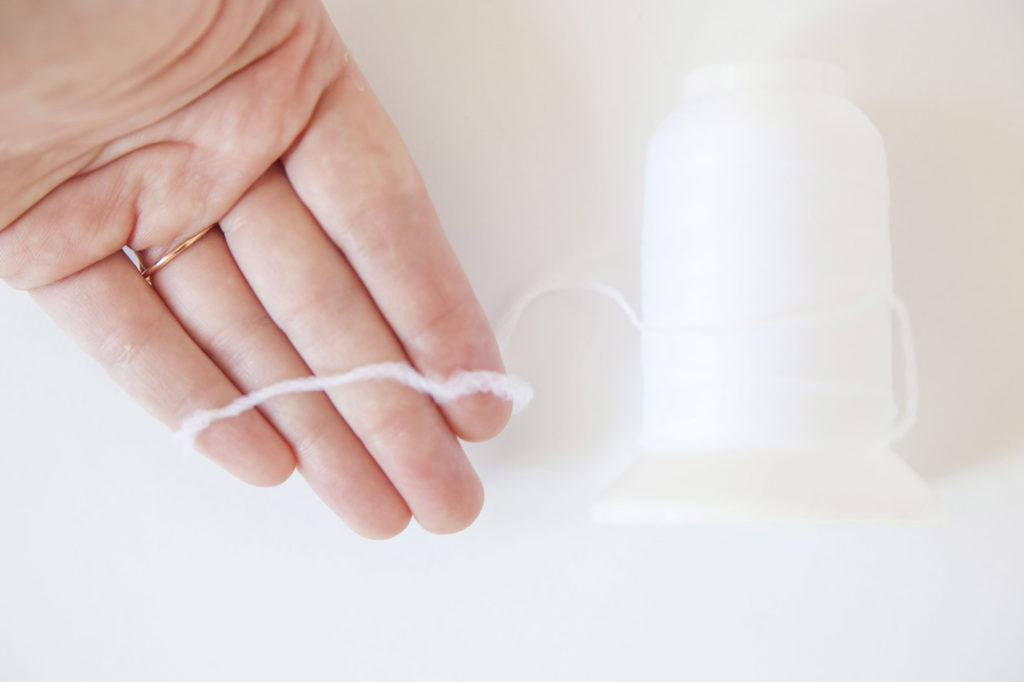How To Make A Swimsuit
Swimwear Nuts
Everything you need to know virtually making your own swimsuit. By Haley Glenn.

My first experience making swimwear was in college. We were assigned to design, draft, and sew a maillot swimsuit in a few days. I had learned the difficult way to blueprint for the amount of fourth dimension you have for execution. My programme for this project was to keep it simple. A trip to the material store soon squashed my small plan, a luscious gold lame fabric defenseless my eye.
I knew I didn't have the time to execute what I wanted and then I heedlessly went with a condom pink color that would exist well suited to a simple shape. I finished my swimsuit with plenty of time, merely I was completely unhappy with the results. Why didn't I just go with my gut? As I presented my projection, I felt embarrassed not because my work was bad, only because it in no way represented my aesthetic. Immediately subsequently giving my presentation, I hopped in my car to buy that gold lame.
I stayed up for the next 36 hours to complete that swimsuit. This new swimsuit would in no way affect my grade in the form, really there was no advantage to making it, simply I did it anyway. That giddy little gold ane piece is still one of my favorite things I have made.
Since then, I accept sewn a lot of swimwear, merely that experience of persistence taught me a valuable lesson that withal resonates with me today. Compromise sparingly, and make choices that make you happy—words that tin be applied in sewing and in life. Making swimwear is an extremely gratifying process. Making a swimsuit custom-fitted to your body and comfort is possibly one of the all-time things always. This guide will accept you through all the basics necessary to brand a loftier-quality swimsuit at home, from choosing fabrics, to finishings.
Cloth
Similar most projects, fabric choice is primal. A poor choice in swimwear fabric, might become heavy with too much captivated h2o, or fifty-fifty go transparent when moisture. On the other hand, a well suited fabric will flatter and last for years to come.
Cocky
Ordering fabric online can be a bit of a gamble. Try ordering swatches and testing the cloth in these four means.
- Soak your cloth in water, does the colour bleed?
- Is the cloth a two- or 4-style stretch?
- If the fabric is printed, does the print crack or distort drastically when stretched?
- Does the opacity of the textile change when stretched?
Swimwear patterns are drafted with negative ease. This means that the finished garment measurements are actually smaller than the body measurements. Choosing a fabric with ample stretch ensures that you lot will exist able to put the swimsuit on and really motion in it.
2-fashion stretch fabric will suit stretch from selvedge to selvedge but does not offering much stretch in the length of grain. This quality make two-way stretch most appropriate for 2-piece swimsuits.
Four-way stretch with stretch from selvedge to selvedge, and too in the length of grain, making it the ideal choice of maillot for one-piece swimsuits too equally two-slice suits.
Swimwear textile should be composed of 100% man-made fibers. Natural fibers such as cotton will absorb water, making it an impractical option. Look for fabrics that are mostly equanimous of nylon (from lxxx% to xc%) but also have a significant corporeality of Lycra or spandex (10% to 20%).
Be certain to exam stretch your fabric to bank check how the appearance might be contradistinct by stretching. Does the material become transparent when stretched? If information technology has a print, does the print go distorted? These are all important things to check for when working with fabric that has a high percentage of stretch.
Lining
Choosing the correct lining is also crucial when making your own swimwear. Halenka lining is ideal for swimwear projects. It offers a soft hand and four-way stretch making it an excellent choice. Halenka is a transparent lining, and while it may provide some modesty, particularly sheer cloth may require more substantial lining.
You tin besides use a neutral-colored swimwear fabric every bit a lining. This provides additional opacity and creates a very stable and house piece. This in an first-class option for achieving a smoothing effect.
Notions
Elastic
Elastic is an important element in your swimwear projects. Information technology offers shaping and holds the garment firmly over again your body. When choosing elastic for swimwear projects information technology is crucial to choose something that will stand upwardly to the affects of water, chlorine, common salt, and lord's day. Traditional polyester elastic volition deteriorate rapidly under these circumstances.
Cotton swimwear elastic is easy to work with and stands up well to chlorinated and salt water. Cotton swimwear elastic is woven with rubber to give it stretch and strength. Just like other elastic, it comes in a multifariousness of widths and is quite inexpensive.
Safety elastic tin can besides be used when making swimwear. This type of elastic can be applied in the aforementioned way every bit its cotton wool analogue, just tin be a footling slippery and more challenging to work with. Rubber rubberband has a lower profile, creating less bulky edge finishes, making it a great choice when bulk is a business organization. This elastic is most commonly found in 1/4" and 3/eight" widths.
Thread

Tips for using wooly nylon thread:
- Wind your bobbin slowly to forestall tension issues.
- Use a needle threader to help thread your motorcar needle when working with wooly nylon thread.
- Exit a long tail when snipping your thread between stitches.
Thread is an of import aspect of any project. After all, it is the ways that literally holds your garment together. With swimwear, the stakes are a bit higher, every bit y'all don't accept anything underneath so salve you from a nip slip or worse.
Avert cotton thread that will become weakened by chlorine and salt water. Instead, opt for a polyester thread. If you are using a serger to assemble your swimsuit, wooly nylon thread is strong and resilient making it perfect for swim and able-bodied-wear. Wooly nylon thread can also be used in your home sewing machine.
Bones Structure
Cutting
Cutting tin can be quite daunting when making swimwear. Slinky swimwear material can accept a listen of its own. Utilize these tips to make cut your material a cakewalk.
- Cut single layer whenever possible. This volition give yous more control as you pivot and sew.
- If using a printed fabric, cutting with the right side facing up. This will help you lot to conceptualize print placement every bit you layout. This will help you avoid an unfortunately placed flower.
- Use brawl betoken pins. This will aid to prevent whatsoever runs in your textile.
- The combination of a rotary cutter and blueprint weights tin can help you to accept more than control as y'all cut.
- Grain line matters! Take extra care to make certain your pattern pieces are on grain before cutting.
Seaming
A serger or a domestic sewing motorcar can exist used for the construction of your project. The following are my favorite techniques, using both types of motorcar.
Apply a serger to sew together swimwear cloth right sides together. Standard seam allowance for most swimwear projects is 3/8". Brand sure your blade is engaged, as you volition exist cutting off approximately 1/8" every bit you sew.
If you are using a domestic sewing machine, a wide and short zigzag tin can be used in place or a serged stitch. A mock overlock stitch can also be a great option. Sew fabric right sides together and trim excess seam allowance.
Always test your sew on scrap fabric and stretch your sample to brand sure that your stitch offers adequate forcefulness and stretch.
Sewing elastic
In nigh cases, elastic is the means by which you finish the edges of your swimwear project. Proper application is key to getting a high quality stop. The most common technique used to apply elastic is the sewn and turned method. This technique offers clean and professional quality results that anyone can achieve at home in just 5 steps.
Stride | 01
Elastic should be cut to be 25% smaller than the opening that it is finishing. To determine this, measure the edge where rubberband is to be applied and multiply this measurement by 0.75. Add together 3/viii" for overlap if sewing in so round, then cut.
Step | 02
If sewing in the round join the two edges of elastic by overlapping and securing with a zigzag stitch.
Stride | 03
Pin elastic to the incorrect side of the raw border, evenly distributing fabric to rubberband.
Step | 04
Use a serger, or a wide and short zigzag stitch to overcast the elastic and fabric together.
Step | 05
Plough rubberband toward the wrong side of the garment, and use a standard or three-pace zigzag to topstitch in place.
Creating Support
Support is a huge concern when it come to swimwear. Though the idea of engineering a swimsuit to not simply stand the test of activity, merely also provide bust support, may seem daunting, these 3 techniques simplify the procedure of supporting your chest.
Cups
Foam cups are a popular option is fix-to-habiliment swimwear. Foam cups offering lite support, and modesty in a wet swimsuit. If you plan on using foam cups, be sure to buy ones that are specifically meant for swimwear. Foam cups intended for lingerie may non stand up to chlorinated or salt h2o, and may absorb large amounts of water.
Pace | 01
Hold lining over bust, identify cup over lining and position to your liking. Mark cup placement.
Step | 02
Pin the loving cup to the wrong side of swim lining.
Footstep | 03
Use a zigzag stitch to border sew together loving cup to lining.
Underwire
Underwire is my favorite fashion of attain additional bust support. Not all swimsuits are designed to be compatible with underwire. If you know that this is a feature you must have in a swimsuit, look for a design that features cups that are attached to a full ring, like Reno. Purchase underwire that corresponds to your bust size and the size swimsuit you lot are making.
Footstep | 01
Before cutting your fabric, alter your flat blueprint so that the nether-bosom seam measures at v/8" seam allowance.
Footstep | 02
Assemble the bra cups and attach cups to band using 5/8" seam assart and a straight run up.
Step | 03
Finish the raw edge with a serger, or an overcast sew together.
Step | 04
Use a straight stitch to peak stitch seam allowance up and toward the bra loving cup, sewing 1/2 away from the seam.
Step | 05
Insert underwire into the aqueduct.
Stride | 06
Run up a small row of stitching at either cease of the channel to keep the underwire in place during the balance of construction.
Stays
Though stays do non actually support the bust in the case of swimwear, they do support the swimsuit past making certain it doesn't end upwardly around your waist. Stays are applied in a very like manner to underwire.
A channel is created by peak stitching approximately three/8" away from a seam. A stay is then inserted into this channel.
When choosing stays for swimwear, look for plastic options, as metallic stays used for dress making volition rust when exposed to water. Plastic stays can also be hands cutting to size.
Always cut your stays to be 1/4″ smaller than the finished measurement of your aqueduct. This prevents the stays from stretching fabric unattractively. A smash file tin be used to round the edges of plastic stays to prevent your stays from injuring you or your swimsuit.
Creating your ain swimwear is a gratifying process. Having a swimsuit that is custom built for your shape and needs is even more than of a thrill. Like about sewing projects, information technology all boils downward to quality materials, planning, and technique. Armed with these iii tools you will be ready to conquer whatsoever swimwear project.
And don't forget, you can learn more than about swimwear in the swimwear sewalong class when you become a Seamwork fellow member. Plus download whatsoever of our beautiful swimwear patterns, like Maggie and Crosby. Become a Seamwork fellow member at half off the usual price today.
Source: https://www.seamwork.com/magazine/2015/08/swimwear-basics
Posted by: coyleworch1941.blogspot.com



0 Response to "How To Make A Swimsuit"
Post a Comment